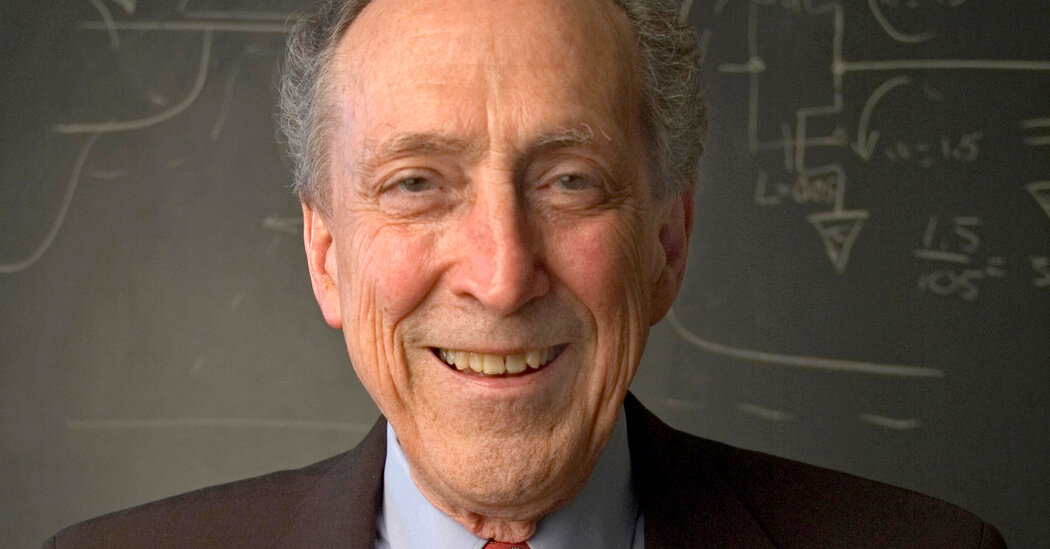
Robert H. Dennard, an engineer who invented the silicon memory technology that plays an indispensable role in every smartphone, laptop and tablet, died April 23 in Sleepy Hollow, New York. At the age of 91.
The cause of death, at the hospital, was a bacterial infection, said his daughter, Holly Dennard.
Dennard's pioneering work began at IBM in the 1960s, when equipment to store and archive computer data was expensive, bulky (often machines the size of a room), and slow. He was studying the emerging field of microelectronics, which used silicon-based transistors to store digital bits of information.
In 1966, Dennard invented a way to store a digital bit on a transistor: a technology called dynamic random access memory, or DRAM, which holds information like an electrical charge that slowly fades over time and must be refreshed periodically.
His discovery opened the door to previously unimaginable improvements in data capacity, with lower costs and faster speeds, all using tiny silicon chips.
DRAM was the basis of steady progress in the decades that followed. High-speed, high-capacity memory chips contain and quickly transfer data to a computer's microprocessor, which converts it into text, sound and images. Streaming videos on YouTube, playing music on Spotify or Apple Music, and using AI chatbots like ChatGPT depend on them.
“DRAM made much of modern computing possible,” said John Hennessy, a computer scientist and president of Alphabet, Google's parent company.
Dennard also came up with a concept that served as a road map for future advances in microelectronics. Debuted in a first paper in 1972 and explored in depth in another two years later, he described the physics that would allow transistors to shrink and become more powerful and less expensive, even as the energy consumed by each would remain nearly constant.
The principle, known as Dennard scaling, was complementary to a prediction made in 1965 by Gordon Moore, who later co-founded Intel. Moore said that the number of transistors that could be crammed onto a silicon chip could be doubled about every two years – and that computing power and speed would increase on this trajectory. His prediction became known as Moore's Law.
Moore's law was about the density of transistors on a chip, while Dennard scaling was mostly about power consumption, and by 2005, it reached its limits: transistors had become so small that they began to lose electrons, causing the chips to overheat and consuming more energy.
But Dennard's approach to identifying technology challenges, researchers say, has had a lasting impact on chip development.
“Everyone in the semiconductor industry studied its principles to get to where we are today,” said Lisa Su, chief executive of Advanced Micro Devices, a large chipmaker and Dennard's former colleague at IBM.
Robert Dennard was born September 5, 1932 in Terrell, Texas, the youngest of four children. His father, Buford Dennard, was a dairy farmer and his mother, Loma Dennard, was a housewife who also worked in a school cafeteria.
The family moved east when Robert was a small child and began his education in a one-room school near Carthage, Texas. The family later moved to Irving, then a small town, when his father found work at a fertilizer company.
Growing up, Robert developed an appreciation for the arts, reading the stories of H. G. Wells and the poems of Ogden Nash that his older sister, Evangeline, had left behind when she left Texas to work as a nurse in the Army during World War II. In an oral history interview for the Computer History Museum in 2009, he recalled listening to an album of Sigmund Romberg operettas countless times. “He left me some really good things to start some sort of intellectual career,” he said of his sister.
In high school he was a good student, especially in math and English, and had planned to attend a nearby college. But his aptitude for music offered him a different path. He played E-flat bass in the high school band, and when the Southern Methodist University band director came to visit, he offered Robert a scholarship.
“That was my opportunity,” Mr. Dennard recalled.
Although music was his entry point, he earned his bachelor's and master's degrees in electrical engineering at the university. She subsequently obtained a PhD. from the Carnegie Institute of Technology, now Carnegie Mellon University.
In 1958, Dennard was hired by IBM, where he spent his entire career until retiring in 2014.
He has been married three times. He and his second wife, Mary Dolores (Macewitz) Dennard, divorced in 1984, and in 1995 he married Frances Jane Bridges.
In addition to his daughter and wife, Mr. Dennard leaves behind another daughter, Amy Dennard, and four grandchildren. His son, Robert H. Dennard Jr., died in 1998.
Over the course of his career, Dennard produced 75 patents and received numerous scientific awards, including President Ronald Reagan's National Medal of Technology in 1988 and the Kyoto Prize for Advanced Technology from the Inamori Foundation, Japan, in 2019.
In the 2009 interview, when Dennard was asked what advice he would give to a young person interested in science and technology, he pointed to his “very humble upbringing” and said that “anyone can participate in it.”
“There are opportunities there,” he said. “These things don't happen on their own. It takes real people to make these discoveries.”
